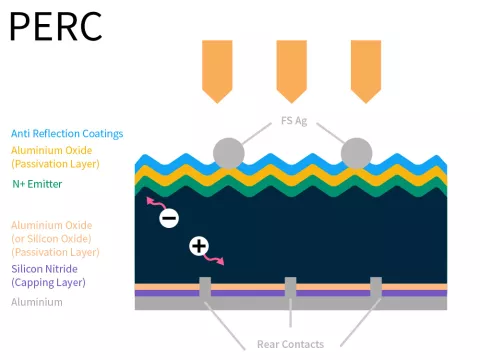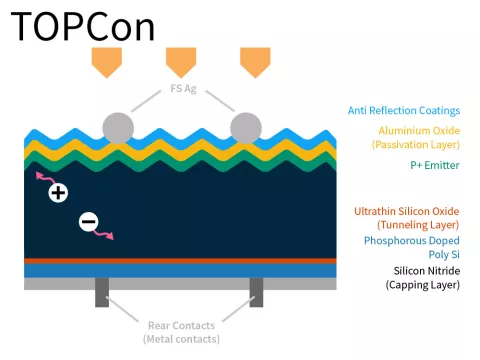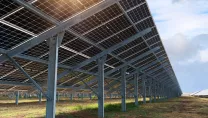The solar industry keeps improving its technology as the demand for cleaner, sustainable energy grows. One of the innovations making waves is TOPCon (Tunnel Oxide Passivated Contact) technology.
TOPCon solar panels offer higher efficiency and better performance than traditional solar cells, making them a promising alternative.
They are slowly displacing the PERC (Passivated Emitter and Rear Contact) technology. This technology has been the leader in the market for the past few years.
What is TOPCon Technology?
TOPCon, or Tunnel Oxide Passivated Contact, is a technology that increases the efficiency of silicon solar panels. The key innovation is the addition of a thin oxide layer between the silicon cell and the metal contacts. This layer helps prevent energy loss, allowing the panel to generate more electricity from the same amount of sunlight. TOPCon panels are more efficient than traditional solar cells, making them a strong choice in the solar market.
TOPCon Modules vs. PERC Solar Panels
Traditional solar cells use silicon wafers treated with chemicals to create either P-type or N-type silicon. When combined, these two types form a P-N junction, which is key to generating an electric field and producing voltage from sunlight.
N-type solar cells, made by doping silicon with phosphorus, serve as the foundation for most TOPCon cells. They apply a layer of boron to create the essential P-N junction.
P-type cells may degrade more quickly in sunlight over time. Boron-oxygen interactions cause this phenomenon, which people call Light-Induced Degradation (LID). N-type cells avoid this issue because they don’t have boron in their base material.
TOPCon solar cells enhance N-type cells. They do this by adding thin layers of silicon dioxide (SiO2) and phosphorus-doped polysilicon to the rear side. These layers enhance the cell's ability to transfer electrons efficiently from the silicon to the metal contacts. This reduces energy losses and boosts the overall voltage and power output of the solar panel.


How TOPCon Improves Solar Efficiency
- Sunlight Absorption: Sunlight hits the solar cell from the top and, in bifacial cells, from the bottom too. The silicon material absorbs this light.
- Electron-Hole Pair Creation: When sunlight is absorbed, it creates electron-hole pairs. Electrons absorb energy and move to a higher state, where they can flow freely. Holes are empty spaces that act as positive charges and move in the opposite direction of electrons.
- Electric Field at P-N Junction: The electric field at the P-N junction moves electrons to the N-type region. It also moves holes to the P-type region. This separation prevents electrons and holes from recombining and wasting energy.
- Electron Movement: The electron will cross the P-N junction. After this, they move toward the rear contact on the N-type layer. This layer will collect electrons.
- Recombination Risk: The N-type layer generates electrons and holes. If holes reach the rear contact, they can cause recombination, which leads to the loss of photo-generated electrons.
- Tunnel Oxide Passivated Contact (TOPCon) Role: TOPCon technology uses a thin SiO2 layer. This layer lets electrons pass through while blocking holes. The polysilicon layer creates an electric field that attracts electrons and repels holes. This helps more electrons reach the rear contacts, where they collect and go to the external circuit.
Evaluating the Pros and Cons of TOPCon Solar Panels
Advantages of TOPCon Solar Panels
- Higher Efficiency: TOPCon solar panels are more efficient than traditional silicon panels and PERC technology. This means they generate more electricity from the same area, making them ideal for places with limited space.
- Improved Performance in Heat: TOPCon panels have a lower temperature coefficient, meaning they perform better in hot climates. Unlike standard panels, which lose efficiency when exposed to heat, TOPCon cells maintain high efficiency even in extreme temperatures.
- Longevity and Durability: The oxide layer in TOPCon cells boosts efficiency and protects the solar cell from damage. This leads to a longer lifespan, making TOPCon solar panels a good long-term investment.
- Cost-Effective in the Long Run: TOPCon panels cost more at first but save money over time because of their better performance. Over time, the extra power from TOPCon panels can cover the initial cost, making them a smart choice for long-term projects.
Cons of TOPCon Solar Panels
- Higher Initial Costs: A key drawback of TOPCon solar panels is their higher manufacturing cost compared to PERC panels. This raises the purchase price for consumers, which can be an issue for smaller projects or those with tight budgets.
- Complex Manufacturing Process: Adding the oxide layer to TOPCon cells complicates the manufacturing process, increasing production time and costs. However, ongoing improvements in production methods may help bring these costs down in the future.
Final Thoughts on TOPCon Solar Panels
TOPCon solar panels are a step forward in solar technology. They provide high efficiency and great performance in hot climates. They also last longer than other options. Although they may cost more at first, their long-term benefits make them a good investment.
This is true for anyone wanting to increase their solar energy production. Whether you’re a homeowner or a business, TOPCon panels offer performance and durability for long-term use.
Ready to take the next step toward more efficient solar energy? Contact us today to learn how our TOPCon solar panels can help you achieve your renewable energy goals!




